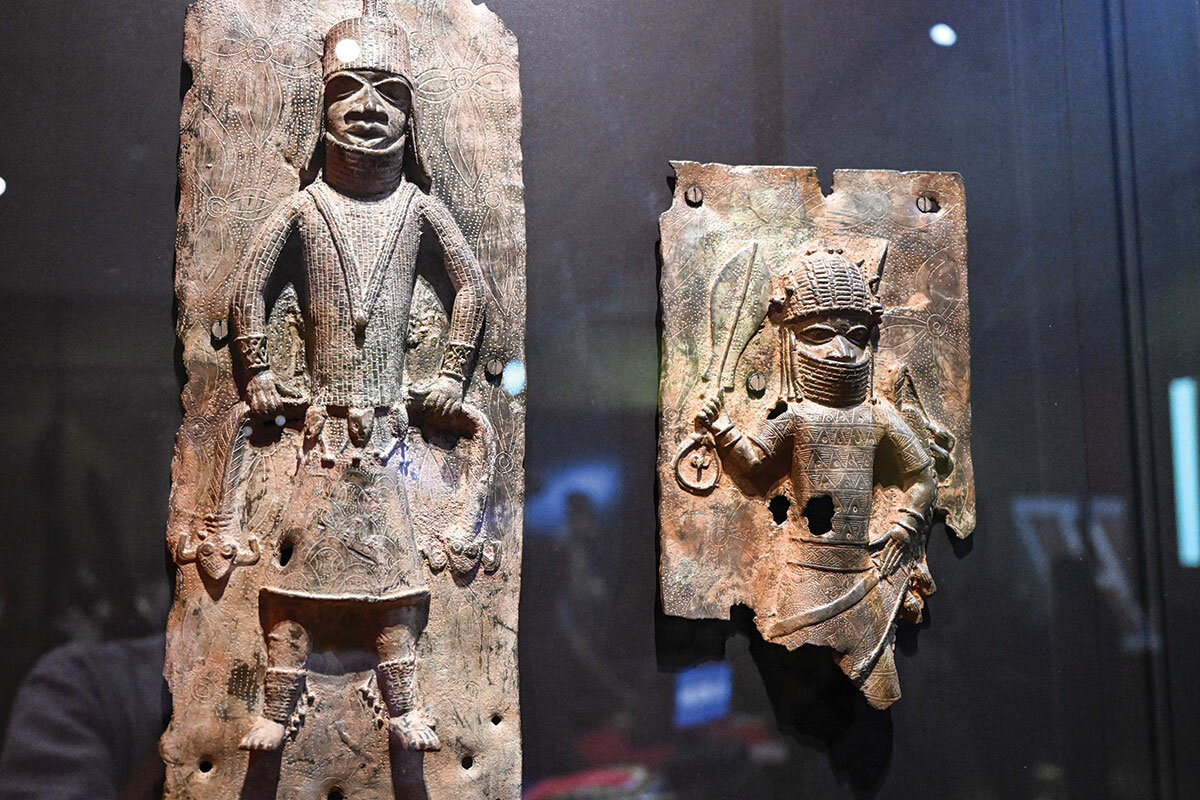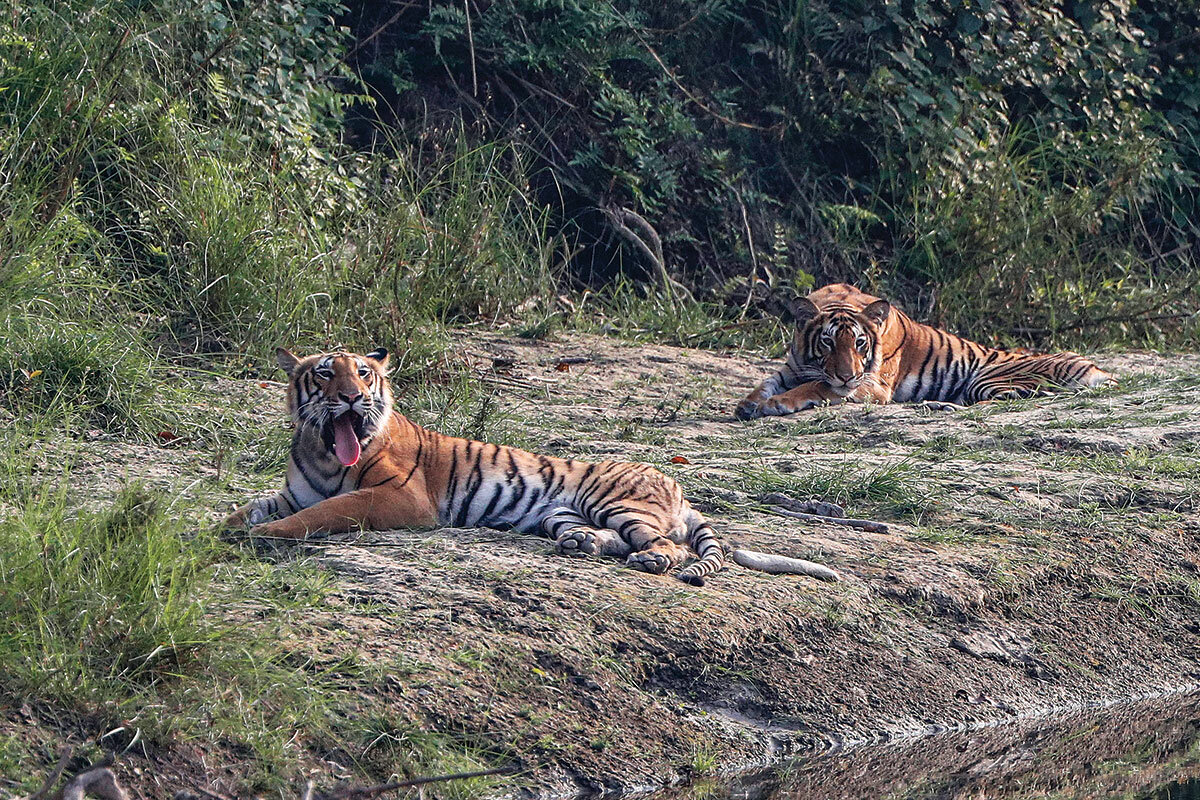Tiger births and Benin Bronzes: Restorations of nature and art
Loading...
A step taken in a positive direction may be scrutinized for whether it goes far enough, especially when the decisions are made at an organization of the size and scope of the Smithsonian Institution.
1. United States
The Smithsonian Institution set new standards for returning items acquired unethically. Most museums have long operated under the assumption that legal possession was enough justification for holding items that were stolen or acquired under duress. In a push for a more ethical and culturally sensitive collections policy, the Smithsonian adopted new guidelines for returning or sharing ownership of artifacts with their origin communities. As one of the biggest players in the field, the Smithsonian is setting an important precedent with its commitment to responsible restitution, observers say.
Why We Wrote This
A story focused onProgress in our news roundup means a return to the past. That includes higher tiger counts in Nepal, and the Smithsonian’s policy of openness toward giving back artifacts to their origin communities.
Earlier this summer, the Smithsonian approved the return of 29 of its famous Benin Bronzes, stolen by British soldiers in the late 1800s, to Nigeria. But it’s not always clear which artifacts were stolen, and the new guidelines don’t include a systematic review of all 157 million objects across 21 museums.
“The notion is to say, when we’re doing exhibitions, when we’re bringing in new collections, let us look at it through an ethical lens,” said the museum’s secretary, Lonnie G. Bunch III. “Or, of course, if we hear from nations or communities about things, that will also trigger the kinds of research that will really allow us to make decisions.”
Sources: The New York Times, The Washington Post
2. Andorra
Civil marriage rights were extended to same-sex couples in Andorra. Lawmakers in the tiny, independent principality wedged between France and Spain unanimously approved the new family code, which grants gay and lesbian civil partnerships the same legal rights as heterosexual marriages. Andorra joins a growing list of at least 28 countries to recognize marriage rights for same-sex couples.
The updated family code also adds rights for all couples regarding alimony and no-fault divorces. “Today we are voting on a law for everyone,” said Carles Enseñat, president of Andorra’s Democratic Parliamentary Group, before the vote. “[It is] a law of a modern country that ensures the free development of citizenship and bases its success on the most primordial organizational nucleus – the family – with all its diversity.”
Sources:Los Angeles Blade, Thomson Reuters Foundation
3. Cameroon
Refugees in Cameroon are creating “eco-charcoal” from biomass, reducing tree felling and landfill waste. Firewood is the most commonly used cooking fuel in sub-Saharan Africa. But an influx of some 60,000 refugees fleeing Boko Haram in Nigeria has put pressure on limited resources shared by local residents and those inside the Minawao refugee camp. So in 2017, the Lutheran World Federation launched an initiative to support the production of eco-charcoal from organic household waste, like corncobs, rice husks, and groundnut shells. So far, around 8,000 households have been trained to make the alternative fuel.
At the Minawao eco-charcoal facility, cooperative members first toast the biomass in a metal barrel, then grind and mix it with water to create a paste that is compressed into bricks and balls. After drying in the sun, the eco-charcoal is ready to sell. The cooperative produces 200 kilograms (440 pounds) of the briquettes per day, with the help of 60 members who are paid with a stipend and their own eco-charcoal supply. Finances are tight, and the group has had to be creative about finding sources of biomass, but those involved call the initiative “a lifeline for survival.”
Source: Mongabay
4. United Arab Emirates
The world’s largest vertical farm opened in Dubai. The United Arab Emirates’ arid climate means the country imports around 90% of its food. Vertical farming, which dates back to ancient Babylon but has gained new momentum in recent decades, is offering hope for local produce.
Dubbed Eco 1, the new 330,000-square-foot hydroponic farm is set to produce over 2 million pounds of leafy greens each year. The facility automates lighting, humidity, and nutrients, avoiding pesticides while using 95% less water than conventional farms. That’s thanks to a closed-loop irrigation system that captures and recycles evaporated water.
The farm is the result of a partnership between Crop One, a Boston-based vertical farming company, and Emirates Flight, the catering arm of the Emirates airline. The idea is gaining steam in other emirates, too: Abu Dhabi recently invested $100 million to study and expand indoor farming.
Sources: Fast Company, Interesting Engineering
5. Nepal
Nepal planned to double its tiger population – but tripled numbers instead. Twelve years ago, the country was home to a mere 121 Panthera tigris. That year, Nepal and 12 other tiger range countries agreed to bring numbers up twofold by 2022, the next Year of the Tiger in the traditional Chinese calendar. Last month, government officials announced a current count of 355 tigers, just 45 shy of the country’s estimated capacity for the species.
Some of that increase can likely be attributed to improvements in the way animals are counted. But experts see undeniable conservation progress, with ripple effects for other species as well as humans. “When we talk about protecting tigers, you’re really talking about protecting the environment that people also need to survive and live a better life,” said Dale Miquelle, tiger program coordinator for the Wildlife Conservation Society.
Source: Mongabay








